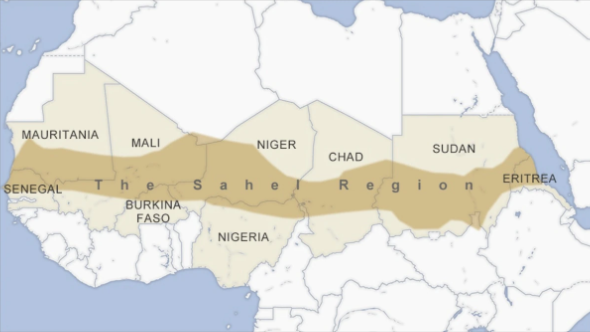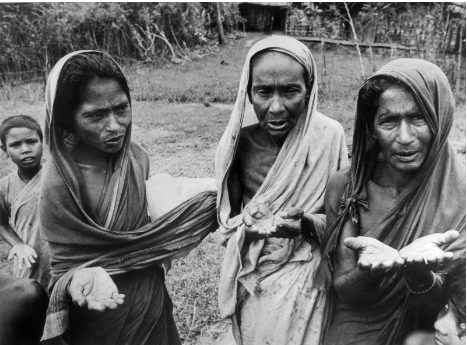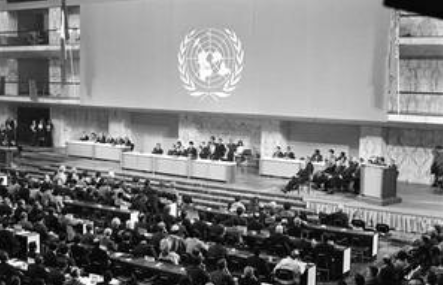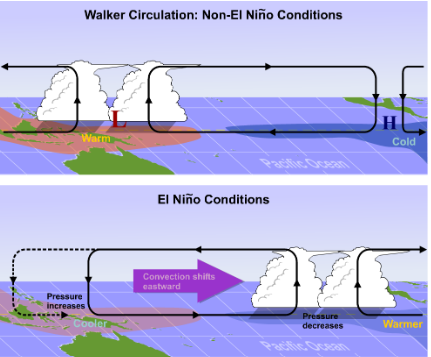What Happened?
- 1972 marks the beginning of a 3-year widespread famine, also known as the world or global food crisis of 1972-1975, that had a death toll of about 2 million people. This famine started with a severe drought in the Sahel Region in Africa (map below). Economic and political policies exacerbated the issue into a devastating famine spanning multiple continents.

Map showing the Sahel Region of Africa and the countries therein (from VOA News).
- In the early 1970’s, Canada, the US, and Australia enacted agricultural policies that subsidized farmers by paying them to NOT grow grain. The purpose of these policies, such as the Agricultural Act of 1970, was to intentionally lower the global stock of grain, thus driving the price up exponentially.
- These policies combined with the severe drought and a particularly strong El Niño in 1972 created a global food shortage hitting the Sahel Region, Bangladesh, India, and the Soviet Union (now Russia and other former Soviet Union republics) the hardest.
- El Niño is a climate pattern of unusual warming of surface waters in the eastern equatorial Pacific Ocean with global consequences.
- While 2 million people were starving to death, and the majority of the world was facing food scarcity and poverty, capitalist industrial countries such as the US experienced an economic boom as their grain sold for astronomical prices.

Starving women in the Bengal region of India and Bangladesh begging for food and supplies in 1974 (from News Statesman).
- After almost 2 years of the global famine, the UN organized the World Hunger Conference in Rome 1974 (picture below). Instead of directly helping the starving masses, the UN decided to focus on self-help and long-term policy. No emergency actions were taken. The idea was that the starving people simply needed to produce more grain. So instead of providing food, the UN gave paltry amounts of seed, fertilizer, and pesticides to the starving countries, which didn’t do much to save the people starving at the time.
- In 1974, the UN created three organizations to address world hunger, the International Fund for Agricultural Development, the Consultative Group for Food Policy and Investment, and the World Food Council. These organizations were low-priority and were given little to no money or resources. They only started to change in the late 80’s and early 90’s, too late for the people suffering from this drought.

The World Food Conference in Rome in 1974 (from FAO).
How is this Related to Climate?
- The catalyst for this famine and 2 million deaths was the drought in the Sahel. For decades, it was believed that the drought was caused by land mismanagement, specifically a positive feedback loop known as the biogeophysical feedback:
- When the vegetation cover is reduced by human activities that lead to deforestation there would be less transpiration, which is an important part of the water cycle where water is released as water vapor from the leaves of photosynthetic plants. When transpiration is decreased there is less water in the atmosphere available to condense and form clouds. With less clouds there would be less rain. The decrease in rainfall would mean that plants would have less water available, resulting in a decrease in surviving vegetation. This process repeats in a vicious cycle that cannot be stopped.
- However, recent studies have shown that this biogeophysical feedback loop may not have been the main cause of the drought. The actual cause were likely global-scale changes in the sea surface temperature or SST related toy a particularly strong El Niño:
- El Niño (diagram below), and its opposite phase, La Niña, are part of the El Niño-Southern Oscillation (ENSO) cycle, which is a complex, large-scale weather pattern driven by temperature variations in the Pacific Ocean. El Niño phases are associated with warmer ocean temperatures and La Niña with colder temperatures in the eastern equatorial Pacific Ocean. Globally, however, because of the complexity of ocean-atmosphere climate interactions, El Niño phases do not necessarily correlate to overall warmer climates and La Niña to overall colder climates, but are instead accompanied by major weather disturbances worldwide. As a result, for example, different parts of the world may experience severe droughts, record rainfall and flooding, unusual number of storms or departures from average temperatures.

Diagram showing the difference between relatively cold normal (top) and much warmer El Niño conditions (bottom) in the eastern equatorial Pacific Ocean (from Penn State Department of Meteorology and Atmospheric Science).
- Researchers are currently studying whether these climate changes were a result of anthropogenic causes or if they were naturally occurring. Scientists are also studying whether we can expect the Sahel to remain a desert, or if the drought will eventually end.
- No one can say for certain if anthropogenic release of greenhouse gasses and the resulting climate change caused the drought and thus the famine of 1972-1975. However, it is certain that these events were triggered by a change in climate.
References and Additional Resources
- Anonymous British army officer. “From the NS archive: Famine in Bengal.” News Statesman. 2020. https://www.newstatesman.com/archive/2020/07/ns-archive-famine-bengal.
- Evers J. “El Nino.” National Geographic Society. 2015. https://www.nationalgeographic.org/encyclopedia/el-nino/.
- “FAO 70th Anniversary”, Food and Agricultural Association, https://www.fao.org/70/1965-75/en/.
- Gerlach C. “Famine Responses in the World Food Crisis 1972-5 and the World Food Conference of 1974.” European Review of History. 2015.
- Giannini A. “Sahel Drought and Global Climate Change.” International Research Institute for Climate and Society. 2007. https://www.populationenvironmentresearch.org/pern_files/papers/Giannini_SahelCyberseminar.pdf.
- “Local and Global Effects of El Niño and La Niña”, Penn State Department of Meteorology and Atmospheric Science, https://www.e-education.psu.edu/meteo3/node/2273.
- Schlein L. “Internal Displacement in the Sahel Tops 2 Million as Armed Conflict Intensifies.” VOA News. 2021. https://www.voanews.com/a/africa_internal-displacement-sahel-tops-2-million-armed-conflict-intensifies/6201123.html.
